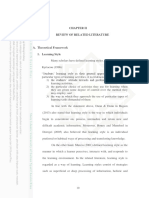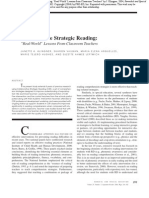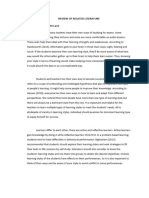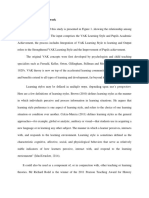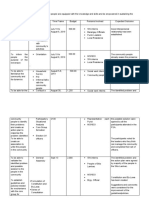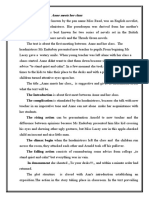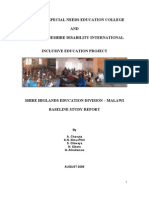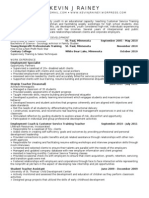Learning Styles: at Oral Exams
Learning Styles: at Oral Exams
Uploaded by
Neon True BeldiaCopyright:
Available Formats
Learning Styles: at Oral Exams
Learning Styles: at Oral Exams
Uploaded by
Neon True BeldiaOriginal Title
Copyright
Available Formats
Share this document
Did you find this document useful?
Is this content inappropriate?
Copyright:
Available Formats
Learning Styles: at Oral Exams
Learning Styles: at Oral Exams
Uploaded by
Neon True BeldiaCopyright:
Available Formats
Learning Styles
Kelly (2017) argued that students learn most effectively according to their personalleaning styles.
According to Sumner (2014), there are 3 types of learning and these are thefollowing: Auditory
Learners; Visual Learners; and Kinesthetic Learners
Auditory Learners
According to Fleming (2017), Auditory Learners are the one who retains the information more
thoroughly when the information is reinforced through sound. The methods can include anything from
using musical notes to memorize lists, to using voice recordings or through memorizing in the way
of chanting. These learners are good at writing responses to lectures they've heard and they're also
good at oral exams.
Visual Learners
Roel (2016) said that the visual learning style are those learners who needs to see information to learn
it, and this "seeing" takes many forms like from spatial awareness, photographic memory, colour or
tone, brightness or contrast and other visual information. Also Visual learners typically do really well
in a modern classroom setting
Jennifer P. (2011), conducted a study with the title “Learning Styles and Their Effect on Student
Learning”. This study explains the different learning styles of students and their capacity to absorb
information from the lessons taught inside the classroom. This study also tackled the effects of the
different ways of learning like active, sensing, visual, and sequential learning. The general purpose of
the study is to inform the teachers 16 that most of the students have different ways of learning
which may affect the students’ learning experience. This study is beneficial to the researchers in
terms of raising awareness about the relationship between retention of information and learning
experiences of the students. This will be noted by the researchers as a guide for a better learning
experience for the population of the study
Mushwana (2000 ) states that in most of the schools, educators display a negative role such as late
coming, absenteeism and substance abuse. He further states that most of the teachers would go to
the classes without having prepared for the lessons and fail to report for the scheduled classes. He
also states that at times teachers do not attend their own periods but dish out notes and
homework’s without dealing with subject matter in class. Mushwana indicates that initiation
ceremonies and absenteeism during child maintenance grant pay days interfere with school work
and keep many Grade 12 learners away from school.
Absenteeism contributes negatively to poor academic performance of Grade 12 learners in most
schools. In the new dispensation, corporal punishment which had previously been an acceptable
means of disciplining learners was abolished and learners are made aware of their human rights
(Badenhorst, Steyn and Beukes, 2007). They indicate that the absence of corporal punishment
eroded the authority of teachers and principals to the point that the maintenance of proper
discipline as for now constitutes a thorny dilemma which impacts negatively on academic
performance of learners.
You might also like
- Research Group 5 1 3Document12 pagesResearch Group 5 1 3Rikka Marie De Lara100% (1)
- Accommodating Students With Dyslexia: A Case StudyDocument5 pagesAccommodating Students With Dyslexia: A Case StudyRam DuranNo ratings yet
- Labor Relations - Mid Term ExamDocument4 pagesLabor Relations - Mid Term ExamNeon True Beldia100% (3)
- Chapter Ii - 2017605pbiDocument21 pagesChapter Ii - 2017605pbijenniemaedomingo2No ratings yet
- MULTIMEDIA AND LEARNING. Multimedia Has Been Successfully AppliedDocument21 pagesMULTIMEDIA AND LEARNING. Multimedia Has Been Successfully AppliedMark anthony FabrigasNo ratings yet
- Term PaperDocument14 pagesTerm PaperAbegail Ventura YengyenganNo ratings yet
- The Effects of Reading Strategies in Comprehension For Elementary PDFDocument39 pagesThe Effects of Reading Strategies in Comprehension For Elementary PDFHahaIkawNaNo ratings yet
- Compiled Sop, Sos, Sad, Chapter IIDocument8 pagesCompiled Sop, Sos, Sad, Chapter IIJason Mark De GuzmanNo ratings yet
- Learning Style in Relation To Academic Performance in ScienceDocument32 pagesLearning Style in Relation To Academic Performance in ScienceMercedita Cagande33% (3)
- Alexander and WoodcraftDocument8 pagesAlexander and WoodcraftGenesis Dalapo AbaldeNo ratings yet
- The Effects of Reading Strategies in Comprehension For Elementary PDFDocument39 pagesThe Effects of Reading Strategies in Comprehension For Elementary PDFEmily-Ylime Obuba Fuentes-SetneufNo ratings yet
- PositionpaperDocument8 pagesPositionpaperapi-322067133100% (1)
- Sbrady Edrd 830 Final PaperDocument25 pagesSbrady Edrd 830 Final Paperapi-456699912No ratings yet
- CRRP ProposalDocument28 pagesCRRP ProposalDennis MacadangdangNo ratings yet
- Echoes and Whispers of Teachers. GROUP 2 2Document11 pagesEchoes and Whispers of Teachers. GROUP 2 2nudalojamlee0904No ratings yet
- Literature ReviewDocument9 pagesLiterature Reviewapi-408336810No ratings yet
- A Study of Relationship Between Learning Preferences and Academic AchievementDocument16 pagesA Study of Relationship Between Learning Preferences and Academic AchievementIrish RoncalesNo ratings yet
- Improving Listening Comprehension Responses For Students With Moderate Intellectual Disability During Literacy ClassDocument20 pagesImproving Listening Comprehension Responses For Students With Moderate Intellectual Disability During Literacy Classapi-255533609No ratings yet
- INCLUSIVE Education - Theory, Policy and Practice Case StudyDocument10 pagesINCLUSIVE Education - Theory, Policy and Practice Case Studyapi-408471566No ratings yet
- NVCDocument9 pagesNVCapi-283921424No ratings yet
- WeinstockannotatedbibDocument9 pagesWeinstockannotatedbibapi-262714178No ratings yet
- Learning Style Copy 2Document25 pagesLearning Style Copy 2ALEXANDRA MARIE NAVARRONo ratings yet
- Klingner Et Al Collaborative Strategic ReadingDocument13 pagesKlingner Et Al Collaborative Strategic ReadingDONEHGUantengbanggetNo ratings yet
- Topical InvestigationDocument12 pagesTopical Investigationapi-354248507No ratings yet
- Ciadmin, Journal Manager, 7496-29911-1-CEDocument12 pagesCiadmin, Journal Manager, 7496-29911-1-CEntkiu04No ratings yet
- Argumentative BiblioDocument10 pagesArgumentative BiblioAbramNo ratings yet
- Review of Related LiteratureDocument4 pagesReview of Related Literaturepermafrancis17No ratings yet
- Ej 1230072Document5 pagesEj 1230072Abderrahim LidriNo ratings yet
- Essay - Student VoicesDocument27 pagesEssay - Student VoicesYomna HelmyNo ratings yet
- Thesis IvdvmvDocument17 pagesThesis IvdvmvJaypee SaymanNo ratings yet
- Oral Reading Fluency and ComprehensionDocument7 pagesOral Reading Fluency and ComprehensionGracy LiteralNo ratings yet
- Educ3050 Proposal SweeneyDocument15 pagesEduc3050 Proposal Sweeneyapi-496910396No ratings yet
- Reading Explicit Instruction - A Classroom Based Study - Dr.M.enamul HoqueDocument14 pagesReading Explicit Instruction - A Classroom Based Study - Dr.M.enamul HoqueDr. M. Enamul HoqueNo ratings yet
- Teaching The Whole ChildDocument13 pagesTeaching The Whole Childapi-294444490No ratings yet
- Annotated Bibliography-Kimberly Harry-Research ProposalDocument6 pagesAnnotated Bibliography-Kimberly Harry-Research Proposalapi-546472618No ratings yet
- Activity MS Word 1Document13 pagesActivity MS Word 1egcajohnpaulNo ratings yet
- Research RRLDocument3 pagesResearch RRLSai WatanabeNo ratings yet
- Comprehension Strategies: Effect On Reading Comprehension of Children With Hearing ImpairmentDocument11 pagesComprehension Strategies: Effect On Reading Comprehension of Children With Hearing ImpairmentFakerPlaymaker100% (1)
- Action Research ProposalDocument18 pagesAction Research Proposalborgek11100% (5)
- Teachersõ Gestures Facilitate Studentsõ Learning: A Lesson in SymmetryDocument18 pagesTeachersõ Gestures Facilitate Studentsõ Learning: A Lesson in SymmetryWided KrimNo ratings yet
- The Relationship Between Learning Styles and Vocabulary Mastery of The Second Grade Students at SMAN 14 SamarindaDocument25 pagesThe Relationship Between Learning Styles and Vocabulary Mastery of The Second Grade Students at SMAN 14 SamarindaMuhammad RamadhaniNo ratings yet
- 7869 71422 2 PBDocument13 pages7869 71422 2 PBGilang PratamaNo ratings yet
- Project SPRSDDocument25 pagesProject SPRSDAnaisa MirandaNo ratings yet
- Research Chap 1 3 Group 1Document20 pagesResearch Chap 1 3 Group 1Alexis CordovaNo ratings yet
- Effective Study Habits Used by Sophomore StudentsDocument30 pagesEffective Study Habits Used by Sophomore StudentsDaryll CastroNo ratings yet
- Related Literature and StudiesDocument4 pagesRelated Literature and Studiesremilynhipolito100% (3)
- Abstract NVCDocument14 pagesAbstract NVCMuhammad Firmal KusyandiNo ratings yet
- Natural Learning Final-CleanDocument10 pagesNatural Learning Final-CleanĐặng Lan HươngNo ratings yet
- Connecting Specific Planned SupportsDocument5 pagesConnecting Specific Planned SupportsKaylee WillinghamNo ratings yet
- Learning Styles EDITED 1 1Document42 pagesLearning Styles EDITED 1 1shierra anneNo ratings yet
- Action ResearchDocument49 pagesAction ResearchMickeyNo ratings yet
- Empowering Students With Disabilities: Cedric TimbangDocument26 pagesEmpowering Students With Disabilities: Cedric TimbangJerico ArayatNo ratings yet
- JoshuaDocument18 pagesJoshuasreeja chandranNo ratings yet
- synopsis roxanDocument6 pagessynopsis roxanamperanafeNo ratings yet
- ResearchDocument7 pagesResearchJimwel GutierrezNo ratings yet
- Sample ProposalDocument7 pagesSample ProposalCharlene PadillaNo ratings yet
- Annotated Portfoliocopysped637 Annot BibDocument8 pagesAnnotated Portfoliocopysped637 Annot Bibapi-348149030No ratings yet
- THE USE OF AUDIO VISUAL TO IMPROVE LISTENING by KiranaDocument13 pagesTHE USE OF AUDIO VISUAL TO IMPROVE LISTENING by KiranaYanuar Rizal Putra UtamaNo ratings yet
- Effects of an Inclusion Professional Development Model on Inclusion Knowledge and Perceptions of Regular Middle School EducatorsFrom EverandEffects of an Inclusion Professional Development Model on Inclusion Knowledge and Perceptions of Regular Middle School EducatorsNo ratings yet
- Effective Homework Strategies: Instruction, Just Do It, #2From EverandEffective Homework Strategies: Instruction, Just Do It, #2No ratings yet
- Organization of Sangguniang KabataanDocument1 pageOrganization of Sangguniang KabataanNeon True BeldiaNo ratings yet
- Applicaion Letter& ResumeDocument4 pagesApplicaion Letter& ResumeNeon True BeldiaNo ratings yet
- Ai-Ai ResumeDocument3 pagesAi-Ai ResumeNeon True BeldiaNo ratings yet
- Arah TheoriesDocument41 pagesArah TheoriesNeon True BeldiaNo ratings yet
- A Portfolio IN Creative Writing: Submitted byDocument22 pagesA Portfolio IN Creative Writing: Submitted byNeon True BeldiaNo ratings yet
- I. Identifying InformationDocument2 pagesI. Identifying InformationNeon True BeldiaNo ratings yet
- Any Person Who Commits An Act As Provided For Under SectionDocument1 pageAny Person Who Commits An Act As Provided For Under SectionNeon True BeldiaNo ratings yet
- Jade Case NewDocument8 pagesJade Case NewNeon True BeldiaNo ratings yet
- MJ CaregivingDocument2 pagesMJ CaregivingNeon True BeldiaNo ratings yet
- Action Plan Sitio LambacDocument7 pagesAction Plan Sitio LambacNeon True BeldiaNo ratings yet
- Group of Senior CitizensDocument14 pagesGroup of Senior CitizensNeon True BeldiaNo ratings yet
- Implication To Social Work PracticeDocument2 pagesImplication To Social Work PracticeNeon True BeldiaNo ratings yet
- Kinds of Excise TaxesDocument8 pagesKinds of Excise TaxesNeon True BeldiaNo ratings yet
- Hermi TYPES OF COMMUNITYDocument2 pagesHermi TYPES OF COMMUNITYNeon True BeldiaNo ratings yet
- Nambong Arts Pri-FinalDocument2 pagesNambong Arts Pri-FinalNeon True BeldiaNo ratings yet
- March 16-31,2018Document11 pagesMarch 16-31,2018Neon True BeldiaNo ratings yet
- I. Identifying InformationDocument2 pagesI. Identifying InformationNeon True BeldiaNo ratings yet
- My One True Love HermiDocument1 pageMy One True Love HermiNeon True BeldiaNo ratings yet
- Neon True C. Beldia Labor Relations Final ExamDocument5 pagesNeon True C. Beldia Labor Relations Final ExamNeon True BeldiaNo ratings yet
- KidlikasanDocument1 pageKidlikasanNeon True BeldiaNo ratings yet
- Michael Case Study (Carla)Document4 pagesMichael Case Study (Carla)Neon True BeldiaNo ratings yet
- Report On Christian Ethics 3Document21 pagesReport On Christian Ethics 3Neon True BeldiaNo ratings yet
- Chemistry: 1 of 20 1 of 34Document73 pagesChemistry: 1 of 20 1 of 34Neon True BeldiaNo ratings yet
- Fine ArtsDocument1 pageFine ArtsLaura Ana SchöneggerNo ratings yet
- Test Items - Cognitive DomainDocument2 pagesTest Items - Cognitive DomainRommel RoyceNo ratings yet
- Application For Bursary: Preferred Field of StudyDocument2 pagesApplication For Bursary: Preferred Field of Studyjadelin thompsonNo ratings yet
- Vietnameses Problems With English GrammarDocument20 pagesVietnameses Problems With English GrammarHu HiNo ratings yet
- Teaching ConjunctionsDocument4 pagesTeaching ConjunctionsWan Hazlina A TajudinNo ratings yet
- Anna Meets Her ClassDocument2 pagesAnna Meets Her ClassCristina PaladeNo ratings yet
- A Rationale For Reading ASPDocument4 pagesA Rationale For Reading ASPAnonymous 4WBHTP6TNo ratings yet
- Malawi StudyDocument42 pagesMalawi StudyKristel Joy Mirasol100% (1)
- Rainey, Kevin - ResumeDocument2 pagesRainey, Kevin - ResumekevinjraineyNo ratings yet
- Motivation Letter: Passive Assistant PracticeDocument2 pagesMotivation Letter: Passive Assistant PracticeAlyona StulinaNo ratings yet
- Justification of Selection SampleDocument5 pagesJustification of Selection SampleJayheartDumapayTumbagaNo ratings yet
- Licensure Examination For TeachersDocument5 pagesLicensure Examination For TeachersLiren LabradorNo ratings yet
- Can I Ask You ... ?: Solutions 2nd Edition Upper-IntermediateDocument2 pagesCan I Ask You ... ?: Solutions 2nd Edition Upper-IntermediateAgo FunesNo ratings yet
- Chapter 8 - Developmentally Appropriate Physical Environments: For Primary-Aged ChildrenDocument1 pageChapter 8 - Developmentally Appropriate Physical Environments: For Primary-Aged ChildrenRosalinda MintreNo ratings yet
- Approches and MethodsDocument5 pagesApproches and MethodsElisaNo ratings yet
- CELTA Pre-Course TaskDocument23 pagesCELTA Pre-Course TaskPablo Martín IbarraNo ratings yet
- LEOS - Official Newsletter of Leo District 306 A2 - August EditionDocument13 pagesLEOS - Official Newsletter of Leo District 306 A2 - August EditionIsuru SenadheeraNo ratings yet
- Tactical Approach To Games For UnderstandingDocument15 pagesTactical Approach To Games For Understandinglos79No ratings yet
- TM 1 TemplatesDocument80 pagesTM 1 Templatesflorence baliwang100% (2)
- Pietrzak Weekly PlanDocument6 pagesPietrzak Weekly Planapi-252745883No ratings yet
- CV Patrick LopezDocument3 pagesCV Patrick Lopezapi-459702299No ratings yet
- Immigration Consultants in MumbaiDocument14 pagesImmigration Consultants in MumbaiGlobal Quest SolutionsNo ratings yet
- Mr. Gautam Is An Interactive and A Curious Person. He Is Duly Updated About What Is Being Taught and IsDocument1 pageMr. Gautam Is An Interactive and A Curious Person. He Is Duly Updated About What Is Being Taught and IsDebendra Dev KhanalNo ratings yet
- Spark Academy ProjectDocument24 pagesSpark Academy Projectakhil goliNo ratings yet
- Choco Matic GizmoDocument6 pagesChoco Matic GizmoDana FredwellNo ratings yet
- Program AuditDocument11 pagesProgram Auditapi-230586540100% (1)
- Lecture 2 Avoiding Plagiarism in Academic WritingDocument21 pagesLecture 2 Avoiding Plagiarism in Academic WritingRavshan KhudoyberdievNo ratings yet
- The Island Way 2012-13Document25 pagesThe Island Way 2012-13api-285303849No ratings yet
- Hist 12 Course OutlineDocument3 pagesHist 12 Course OutlinemrkludemanNo ratings yet
- Self Determination LessonDocument4 pagesSelf Determination Lessonradke4No ratings yet



